
"WELCOME TO MY GARDEN"
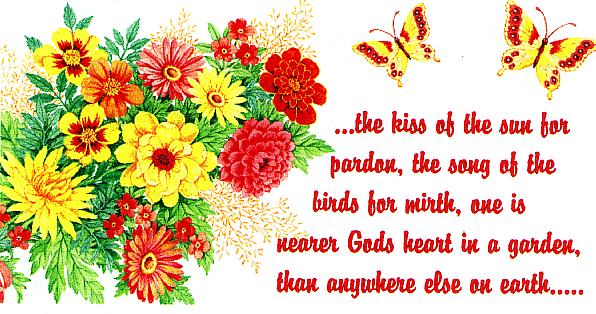
The excerpt above was taken from one of my favorite poems, by Dorothy Frances Gurney, "The Lord God Planted a Garden."
I find so much peace of mind as I work in my garden and solitude as I sit admiring Gods handiwork. I spend hour after hour in my garden. I feel there is no better way to get exercise and enjoy doing it. I hope you enjoy looking around through my perennials. I have almost every kind that will grow in our zone. In fact, I have a problem finding anything new and different in our local garden centers. My backyard is small and most of it is in perennial beds now. A few years ago we had a vegetable garden in part of the yard. Over the years I took more and more of it and turned it into perennial beds. We now go to the market for our veggies. I told my husband that, "we didn't need food, we needed flowers". He didn't care because he was tired of raising vegetables too, I think. I usually have a tomato plant or two somewhere among my flowers. I hope you enjoy looking through my gardens just half as much as I do. If you are a flower lover, as I am, I think you will.

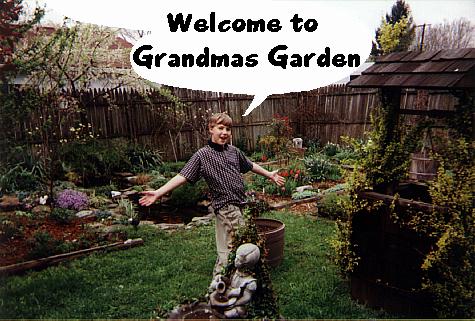
"My gardening buddy, Jared"
My grandson Jared, is showing you a good view of the left side of my garden in spring, in fact it was this past Easter. This will give you some idea of how much the flowers outgrow their boundrys within a few months. You can actually see the ground between the plants! That don't last long as you will see in pictures coming up.
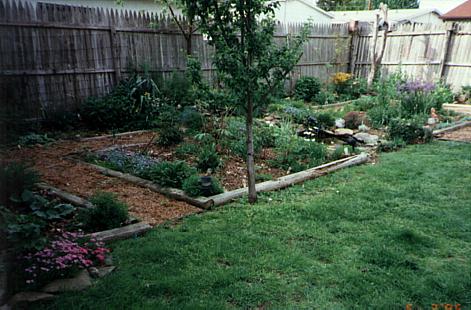
Ok, I know, this is almost like the photo above. It's another view of the left side of my garden. I'm trying to give you an overall picture of the garden. I hate trying to use my imagination when I'm looking at individual flowers and have to guess at where they might be located in the garden. I hope this will not confuse you too much. Just put these three photos in your mind and you will be in my garden. You might want to pull a weed or two while you're here.

This view is taken straight through the middle of the garden. My birdbath/fountian and wishing well are in the middle and in line with the center bed in back. My area is so small that I had to keep things organized to keep it from looking too cluttered. The little fountian was a birthday gift from my children. It has a pump which circulates the water from the birdbath up and out of the pitcher that the little girl is holding. I put the scalloped edging around it which makes a perfect place for planting annuals. I also planted fern around the base.---The wishing well was an idea that I got from one that I saw at a garden center in a neighboring town. I got my paper and pen out of my purse and drew a picture of it. I had to guess at the measurments but as you can see, it turned out quite nice, if I did build it myself--believe it or not! I've had lots of compliments on it. I bought the wooden bucket from an Amish store up in Ohio.
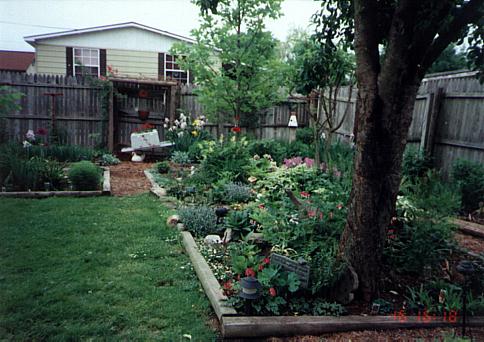 This is a view of the right side of the garden. As you can see its in a U-shape, using my privacy fence as its boundry. I love the rustic look of the fence. I kept everything as rustic as I could. Nothing was painted at all until about two years ago, when I bought a couple of white benches.
You can also see from these photos that I have laid my beds out into 8 by 8 foot squares, except for the one behind the wishing well and its 8 by l6 feet. All of the paths between and around the squares are about 30in. wide. Just wide enough to get my wheelbarrow through.
This is a view of the right side of the garden. As you can see its in a U-shape, using my privacy fence as its boundry. I love the rustic look of the fence. I kept everything as rustic as I could. Nothing was painted at all until about two years ago, when I bought a couple of white benches.
You can also see from these photos that I have laid my beds out into 8 by 8 foot squares, except for the one behind the wishing well and its 8 by l6 feet. All of the paths between and around the squares are about 30in. wide. Just wide enough to get my wheelbarrow through.
From here on I want to show you individual perennials. Some of my photos were not taken close enough to do this properly. When I snapped these pictures, I had no idea that I would be showing them in this fashion. I'm numbering each photo and describing the main flower. As you go along, if you see something in the background or somewhere in the photo that interests you, send me an email giving me the photo number and describe the flower in question. I'll get back to you giving you its name and information about it.
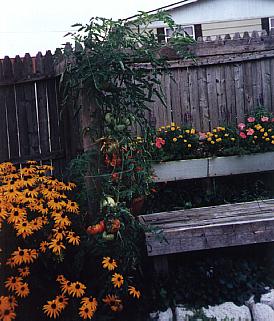 (1) "GOLDSTURM' BLACK-EYED SUSAN (Rudbeckia family)
(1) "GOLDSTURM' BLACK-EYED SUSAN (Rudbeckia family)
There are many different types of Rudbeckia. Lots of my plants are in that family. I just go by the common name when I tag my plants. This plant is one of my favorites. It blooms for over a month in late summer. It has one habit that can be annoying. It can pop up in unexpected places. I've learned the leaf on the new plants so, you guessed it, I just pull it up and discard it. It likes to be separated about every other year to keep it thriving. It grows best if planted in a sunny spot, where you are going to need color in late summer. It is a real hardy plant and can be kept for years if separated in the spring and replanted.
Notice my tomato plant growing beside the old bench. Look how tall it grew. We got all the tomatoes that we needed off that one plant. The old bench has since rotten away and I now have a white one in its place. I put the planter on the fence behind it. Thats been a perfect place for petunias, but I'm afraid I'll have to go to impatients next year. Its getting a little too shady for petunias, I think.
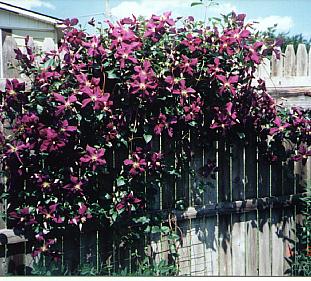 (2)JACKMAN'S CLEMATIS
(Ranunculaceae family)
(2)JACKMAN'S CLEMATIS
(Ranunculaceae family)
I have found that this is the most hardy of all clematis. I've had this variety for about 20 years. The reason I know its been that long is because my Mother bought me one some time before she passed away. I thought it had died this year and cut it completely to the ground and bought this one. One day, much to my surprise, Moms clematis started to grow again and had a few blooms! I'm taking care of it because I'd like to keep it as long as I can. This variety needs to be trimmed back each spring to about l2 to l8 in. above the ground.
They like a sunny spot in any good garden soil, but need to have their feet damp and shaded. I plant some kind of a low growing plant around its base to keep the soil cool and shaded.
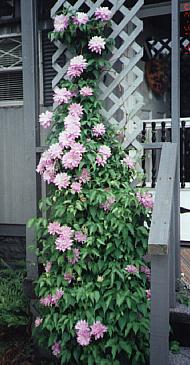
This variety of the Clematis has double blooms that are much larger then the single flowering ones. Its habits and care requirments are the same except for trimming. I bought this one "on sale" with no name or growing instructions with it. I treated it much the same way as every other Clematis that I had owned. The first year it grew and had a few blooms, but I didn't trim it hoping to have a larger plant the following year. That year it did great and was beautiful with an abundance of large bloom 5-6 in. across. The next spring I trimmed it just like I had always trimmed my Clematis in the past. There was lots of nice sized blooms, but they were all at the base of the vine on the old wood and a beautiful vine without bloom covered my trellis. I read everything I could find on Clematis and soon found out that there are two different kinds and need trimming at different times. I found that this one needed the vine that had bloomed, cut out and leave the new growth for the next years bloom. So by trial and error I finally got it right.
If any of you have any tips on how to tell the differance in these two plants before having to trim them wrong for two years, Please let me know. :)
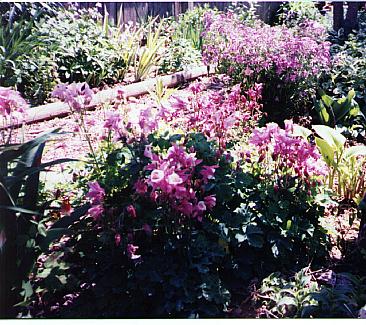
(3) COLUMBINE (Aquilegia)(Buttercup family)
I have different colors of Columbine, blue, 3 shades of pink and gold/yellow. They are a good addition to any garden. The only bad thing about them is that they don't stay true to color if they are planted too close together. These in the photo have been in the same spot for 3-4 years. I made sure I planted other colors in other parts of the garden. They are extremely easy to grow. They self seed so there is usually some to give to my gardening friends. Columbine do well in light, average to rich, moist but well-drained soil. They will grow in full sun or partial shade. They bloom from spring to early-summer.
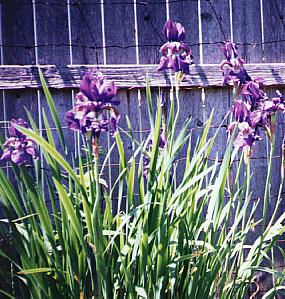 (4) 'SIBERIAN IRIS' (Iris family)
(4) 'SIBERIAN IRIS' (Iris family)
I'm not sure this is a Siberian Iris. This name is the closest that I can find in my Gardening Encyclopedia. Its not like the bearded Iris which has shorter blades. This one has a thick grassy blade, and stays in a clump much like the Day Lily. I got this one in the mountians of my state at an old farm we were visiting. It had been discarded to a dump and was blooming beautifully when I saw it. I rescued it and brought it home with me and have had it ever since. I've shared it with gardening friends and family but nobody has given me a name for it yet, that is to my satisfaction. It will grow in any sunny or part shade location and likes any garden soil. It should be divided every 3-4 years. The clump is really hard to devide if it gets too big. So, let me know the real name for this, if it isn't a Siberian. I'd be pleased to know the poor little things real name.
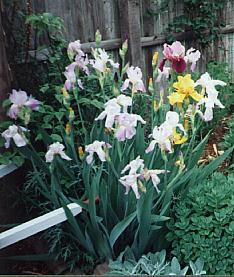 (5)IRIS' (Mixture)
(5)IRIS' (Mixture)
These are different from the ones described above. These are, what I call, the standard old fashioned Iris. I've had this clumb for quite a few years, and they are the first ones I planted. These came from my sister Rebas garden. She couldn't believe I didn't have iris in my garden. They were never one of my favorite flowers for some reason. In the past five years I've been given so many by friends who were thinning theirs, that I had to make room for them. I've never bought one and I now have a sixteen ft. row of mixed colors and I have a few scattered through my garden among other plants. A lot of them are the beautiful bearded type. Those people made sure I had Iris, whether I wanted them or not!!
This type grows from thick creeping rhizomes that lay on top of the ground with roots on the underside that grows into the ground. If the rhizomes are planted too deep, the Iris grows but seldom bloom until it works itself to the top of the ground. So when planting make sure just the little string roots are put into the ground and just put dirt around the sides of the rhizome. If covered over, make sure not more than an inch deep. They need a sunny location and will grow in any kind of soil. In late summer or early fall the blades can be trimmed back to within six inches from the ground.
 (6) 'THE ROCKET' (Phlox family)
(6) 'THE ROCKET' (Phlox family)
This is a spring favorite of mine. This can almost be considered a wildflower in our state. Since I've had mine, I've seen them blooming along side of roads, on banks and ditches. Its biennial so, special care has to be taken to be sure I have some year after year. If you are reading this, I'm sure you already know what a biennial is. For those of you, who might not know what that is, its a plant which requires two years to complete their life cycle. They bloom the second season after seed have fallen or saved and replanted. But once the cycle is started, its as simple as enjoying the blossems of last years plants while caring for plants for nest years bloom. Its as simple as that.
My first experience with a Rocket, was several years ago, when my sister, Tots, gave me some small plants from a packet of wildflowers she had sown. I thought if I deadheaded it, it might keep blooming. Needless to say, I cut all my seeds away which left me with nothing!!! When a gardening friend gave me another start, I had learned how they had to be cared for. Now I have more than I need each spring. I give them away or throw them away, whichever comes first. :) They will grow in any kind of soil, but if new seedlings are wanted, the soil needs to be loose enough for the seeds to start once they have ripened and fallen. Mine have always been in full sun. Thats where I see them in their natural, wild settings. Again, Rocket, is the only name I've found that fits this plant. Does anybody have more information on this plant? If so let me know. I'm not an expert, just a flower lover.
 <6> 'BUSH AZELEA'
<6> 'BUSH AZELEA'
This little orange Azelea was given to me for Mothers Day by my daughter, Dorenda about five years ago. It can, like other plants I have mentioned, be found growing wild in the mountians of our state. I have admired them in their natural environment
for years. When she bought this one and paid thirty dollars for it, I went crazy. When I was a child, they were called bush Honeysuckle. This is one of my big pet peeves. Its supposed to be unlawful for me or anyone else to dig a wildflower or bush, but she goes to a garden center and buys this. Where do you think they got it? Well, anyway let me get down off my soap box and get back to the "wild bush Honeysuckle", Azelea or whatever it is. Unlike the true Azelea this one is really hardy. It don't need much TLC at all. I planted this one and have done nothing to it since and it just keeps growing and blooming. I give it a drink of liquid acid fertilizer in spring and sometimes after it blooms, if I think of it. I know at the edge of forests, where they naturally live, they get an abundance of leaf mulch so in the fall I mulch it with leaves. Its almost maintance free except for a trim. When it needs a trim, it has to be done right after blooming. It, like all spring flowering shurbs, starts setting buds for the next years blooms early. Trim it too late and be shocked nest year with no bloom. How do I know? Guess! A good addition for any garden.---(Notice the Rocket beside it that I described in #5 above.)
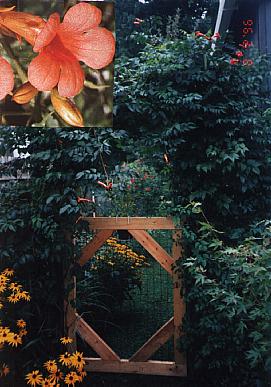 (7)'RED TRUMPET CREEPER'
(7)'RED TRUMPET CREEPER'
Trumpet Creeper is exactly the right name for this vine. It covered this wire arch over the gate in no time. This one came from an old farm, where one of my gardening friends lived as a child. The creeper had covered one side of an old barn. I found a small piece, dug it up and here it is. It has long red-orange trumpet shaped blooms. It is an eye-catcher even when not in bloom. It wasn't blooming at its best at the time of this photo. The insert in the photo turned out to be more orange than the bloom really is. As you can see in the main photo, they are more red than orange. I think the sun shinning on it made it look orangy. Anyway thats what it looks like close up, only red. It needs nothing except a good trimming once in awhile and lots of sun. It will grow but not bloom in the shade. I trim it anytime it gets unruly except when its in bloom. Its an easy plant to grow, but caution must be taken. It can grow between shingles on the roof or under siding pulling it off. Thats why I have it on an arch so I can keep it under control.
The gate is a side entrance to my back yard and garden. It was originally used to keep my little dog in the yard. Now that I no longer have a dog, it keeps the rabbits out! I just like the rustic look anyway.
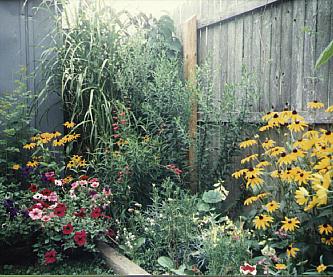 (8)'PAMPAS GRASS'(Gramineae family)
(8)'PAMPAS GRASS'(Gramineae family)
This bed is located just inside the gate.(above) This is the first place seen when entering the side entrance before going into the main garden. I'm using this photo to show how plants can be used as covers. The tool/storage building sets about four feet from the fence making a perfect place for my compost bin. When this Pampas grew to over six feet tall, I moved it here to hide the compost. I also put a piece of lattice to help with the cover. My compost cannot be seen at all from this location. This grass has a green/white variegated blade. Its very attractive in the fall when it has long white flower panicles. These are great when dried and used in dried flower arrangments. It needs no special care. Just cut it back in the fall, and listen to this! My gardening books says to burn it in spring to get rid of all the dried stubble. It works! I figured I would kill it, but it sure makes for a neater looking plant when it starts to grow again.
The Petunias are in an old square zinc washtub. At the time of this photo the petunias had grown so big, the tub is hidden. I told you I liked Black-eyed-susans, see there they are again!
 (9)'POPPY' (Papaver)
(9)'POPPY' (Papaver)
This name covers all poppys. I believe, after looking through my gardening books, that this one in the Corn Poppy (P. Rhoeas). Its referred to as an annual species. I have always thought that this poppy had creeping roots, because they pop up all over the bed. After reading about all kinds of poppys, I've decided that this one self-seeds and in probably a biennial. I have so many every spring that I've never noticed that all of the plants don't bloom. They are deep rooted and I find it really hard to dig one up and get all the root. They are a bright red/orange and the bloom can be as large as five inches across. Their folage is short and each flower is at the end of an l8-24 inch stem. After blooming they become very untidy and soon disappear altogether. Thats why I have them growning among my daylilys and iris. By doing this, the poppys fill the open spaces in early spring and are gone by the time the daylilys and iris need the space. This also keeps me from digging them up in error while they are dormant. They really should have soil on the sandy side, but mine are in plain garden soil. So far so good, I always have plenty of beautiful blossoms every spring.
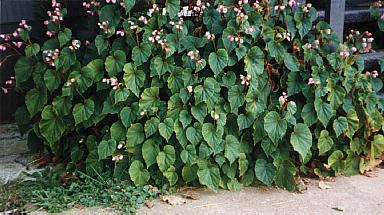 (10)'HARDY BEGONIA'(Begoniaceae, Begonia family)
(10)'HARDY BEGONIA'(Begoniaceae, Begonia family)
This is by far the best perennial I have for shade and fall blooming. It likes open shade which means sunlight shinning though tree leaves, but it will grow in some late day sun. About eight years ago, I went to the Elizabethan Gardens, in Mantea, S.C. with my daughter. We were down there on vacation, and the two of us went to see these beautiful gardens. After touring the gardens, we ended up in their greenhouses that were on the garden grounds. We both had commented on these begonias growing in the gardens and wondered if they would grow in our zone. We were told that the zone there was not much different than ours and were assured that they would do fine in our gardens. I've had it eversince. They like evenly moist, humus-rich soil. They propagate by seeds(bulbils that grow in the leaf axils). I guess in some parts of the country, the seeds should be saved and planted in summer, for fall bloom. I just let mine self-seed. When they come up in mid-summer I thin them, if I feel they are too thick. These you see in my photo came back this year from one plant that I transplanted to this space last year. I didn't get around to thinning them, but they turned out pretty, don't you think? Maybe I've been thinning too much in the past.
 (11)'BLEEDING HEART' (Dicentra-Fumitory family)
(11)'BLEEDING HEART' (Dicentra-Fumitory family)
The bleeding heart got its name because of its unique flowers, which look like pink hearts with drops of blood dangling from their tips. Its foliage is deeply divided and often fernlike. The one in my photo is the common bleeding heart (Decentra spectabilis). It blooms with lilacs and late tulips. Behind this plant is a solid white bleeding heart that I didn't get in the picture. Maybe next year when it blooms, I'll get it to pose for you while its all dressed up in white. :) Like everything else, there are different species of bleeding heart. All, or most, grow from thick, brittle roots or tuberous rhizomes. In hot climates it needs lots of light shade, but in cooler places it can grow in sun as long as the soil is kept moist. Mine is in, what I call, my shade square. They only get late afternoon sun but I try to keep the soil moist during their blooming period. They go dormant after blooming and disappear altogether. I have to keep their spot marked, or I forget they're there. I also have Prim rose and little white English daisies growing in the front of the bed.
Another pretty bleeding heart is the 'Luxuriant'. I used to have one of these, but for some reason I have trouble keeping them alive. I've got to learn more about their habits before I try again. I'm sure I'll try growing it again sometime. Its bloom is solid pink without the white blood drop. Its well worth another try. Know anything about these? Please let me know.
Please go with me to see more photos and hear more about some of my gardening experiences.
Come on, please don't go,
lets look a little more! :)
*Quick links to my other pages*
 My Garden
My Garden |
 Garden Ponds
Garden Ponds |
 Dorendas Garden
Dorendas Garden |
 Poetry
Poetry |
 My Morning prayer
My Morning prayer |
 A Tribute
A Tribute |
 Prayers/Inspirations
Prayers/Inspirations |
 Life Over Forty
Life Over Forty |
 West Virginia Snow
West Virginia Snow |
 West Virginia Fall
West Virginia Fall |
 Home
Home |
 West Virginia
West Virginia |
 My Awards
My Awards |